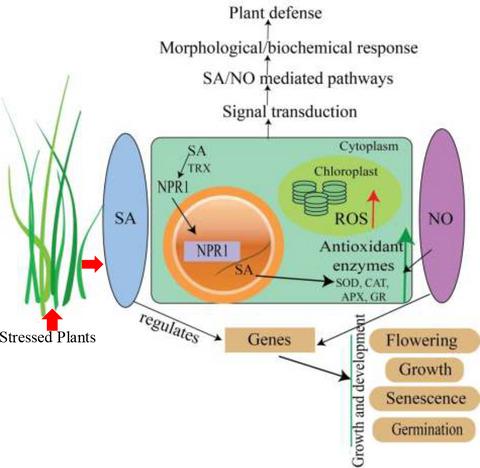当前位置:
X-MOL 学术
›
Plant Biol.
›
论文详情
Our official English website, www.x-mol.net, welcomes your
feedback! (Note: you will need to create a separate account there.)
Nitric oxide (NO) and salicylic acid (SA): A framework for their relationship in plant development under abiotic stress
Plant Biology ( IF 4.2 ) Pub Date : 2021-02-15 , DOI: 10.1111/plb.13246 Ved Prakash 1 , Vijay Pratap Singh 2 , Durgesh Kumar Tripathi 3 , Shivesh Sharma 1 , Francisco J. Corpas 4
Plant Biology ( IF 4.2 ) Pub Date : 2021-02-15 , DOI: 10.1111/plb.13246 Ved Prakash 1 , Vijay Pratap Singh 2 , Durgesh Kumar Tripathi 3 , Shivesh Sharma 1 , Francisco J. Corpas 4
Affiliation

|
The free radical nitric oxide (NO) and the phenolic phytohormone salicylic acid (SA) are signal molecules which exert key functions at biochemical and physiological levels. Abiotic stresses, especially in early plant development, impose the biggest threats to agricultural systems and crop yield. These stresses impair plant growth and subsequently cause a reduction in root development, affecting nutrient uptake and crop productivity. The molecules NO and SA have been identified as robust tools for efficiently mitigating the negative effects of abiotic stress in plants. SA is engaged in an array of tasks under adverse environmental situations. The function of NO depends on its cellular concentration; at a low level, it acts as a signal molecule, while at a high level, it triggers nitro‐oxidative stress. The crosstalk between NO and SA involving different signalling molecules and regulatory factors modulate plant function during stressful situations. Crosstalk between these two signalling molecules induces plant tolerance to abiotic stress and needs further investigation. This review aims to highlight signalling aspects of NO and SA in higher plants and critically discusses the roles of these two molecules in alleviating abiotic stress.
中文翻译:

一氧化氮(NO)和水杨酸(SA):非生物胁迫下它们在植物发育中关系的框架
自由基一氧化氮(NO)和酚类植物激素水杨酸(SA)是在生化和生理水平上发挥关键功能的信号分子。非生物胁迫,特别是在植物早期发育中,对农业系统和农作物产量构成最大威胁。这些压力会损害植物的生长,并随后导致根系发育减少,从而影响养分吸收和作物生产力。NO和SA分子已被确认为有效缓解植物中非生物胁迫的负面影响的强大工具。SA在不利的环境情况下从事一系列任务。NO的功能取决于其细胞浓度。在低水平时,它充当信号分子,而在高水平时,它触发硝基氧化应激。NO和SA之间涉及不同信号分子和调节因子的串扰在胁迫情况下调节植物功能。这两个信号分子之间的串扰诱导植物对非生物胁迫的耐受性,需要进一步研究。这篇综述旨在突出高等植物中NO和SA的信号传导方面,并严格讨论这两种分子在缓解非生物胁迫中的作用。
更新日期:2021-04-12
中文翻译:

一氧化氮(NO)和水杨酸(SA):非生物胁迫下它们在植物发育中关系的框架
自由基一氧化氮(NO)和酚类植物激素水杨酸(SA)是在生化和生理水平上发挥关键功能的信号分子。非生物胁迫,特别是在植物早期发育中,对农业系统和农作物产量构成最大威胁。这些压力会损害植物的生长,并随后导致根系发育减少,从而影响养分吸收和作物生产力。NO和SA分子已被确认为有效缓解植物中非生物胁迫的负面影响的强大工具。SA在不利的环境情况下从事一系列任务。NO的功能取决于其细胞浓度。在低水平时,它充当信号分子,而在高水平时,它触发硝基氧化应激。NO和SA之间涉及不同信号分子和调节因子的串扰在胁迫情况下调节植物功能。这两个信号分子之间的串扰诱导植物对非生物胁迫的耐受性,需要进一步研究。这篇综述旨在突出高等植物中NO和SA的信号传导方面,并严格讨论这两种分子在缓解非生物胁迫中的作用。
















































 京公网安备 11010802027423号
京公网安备 11010802027423号